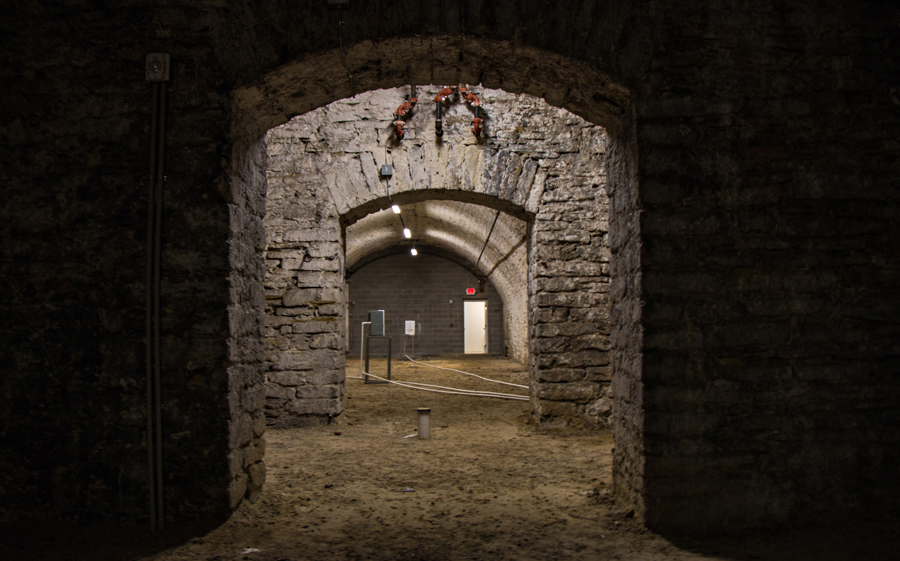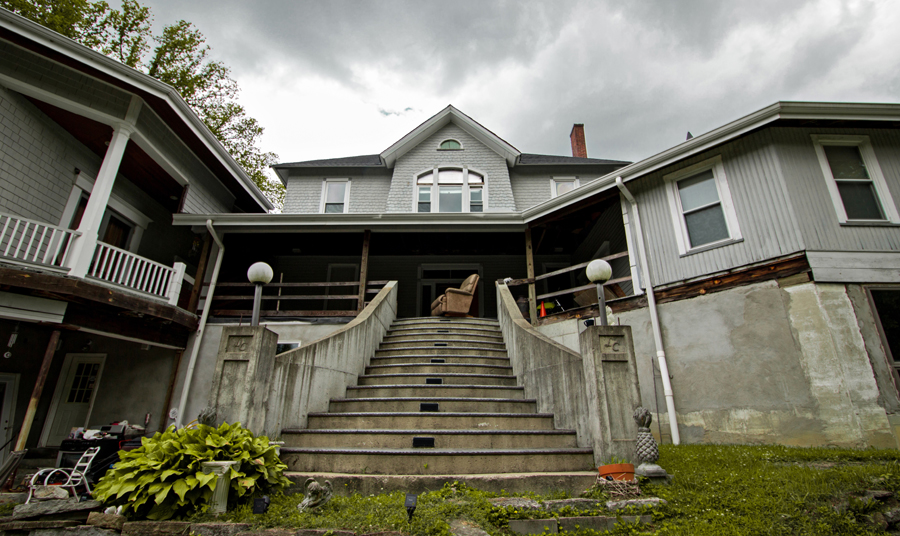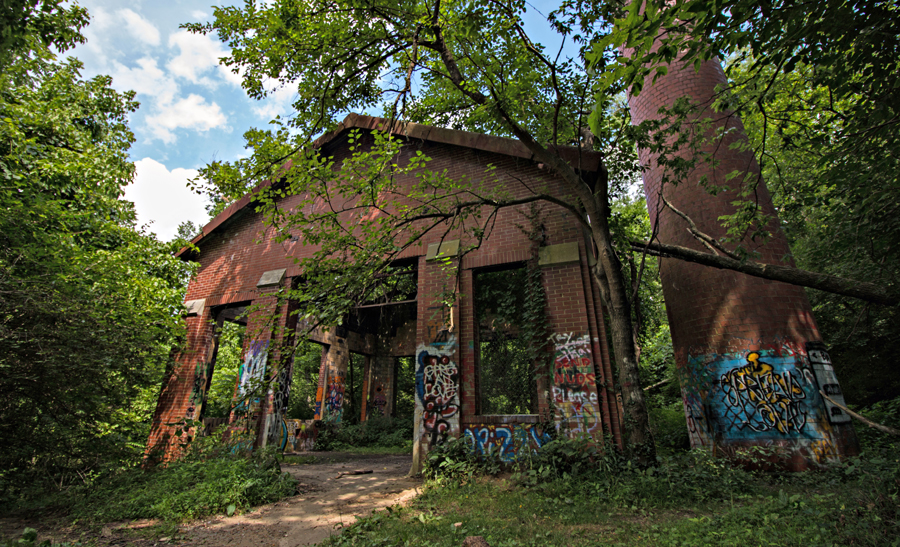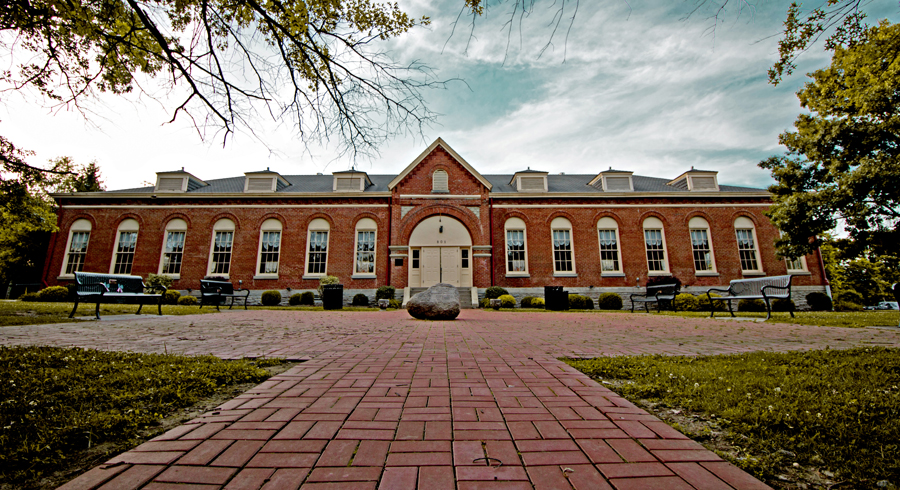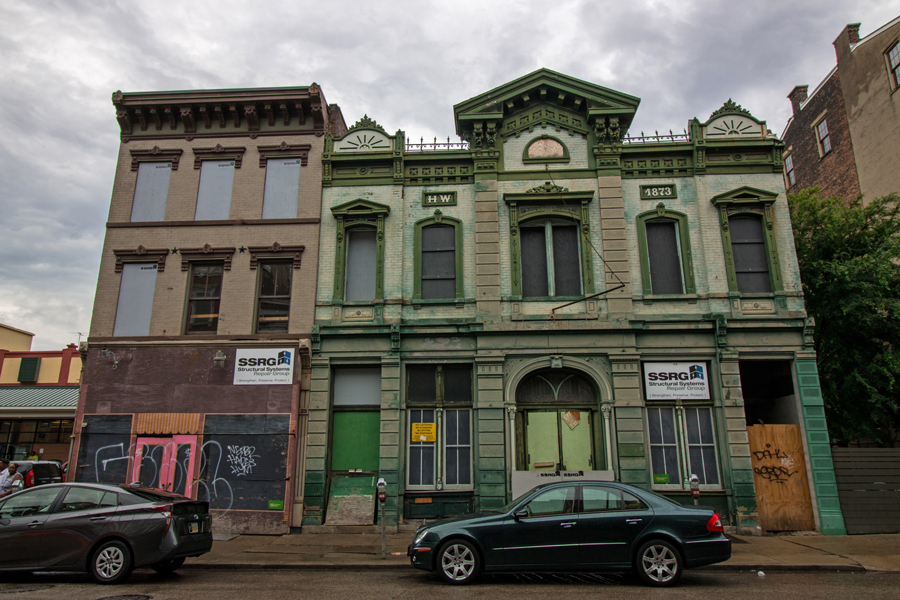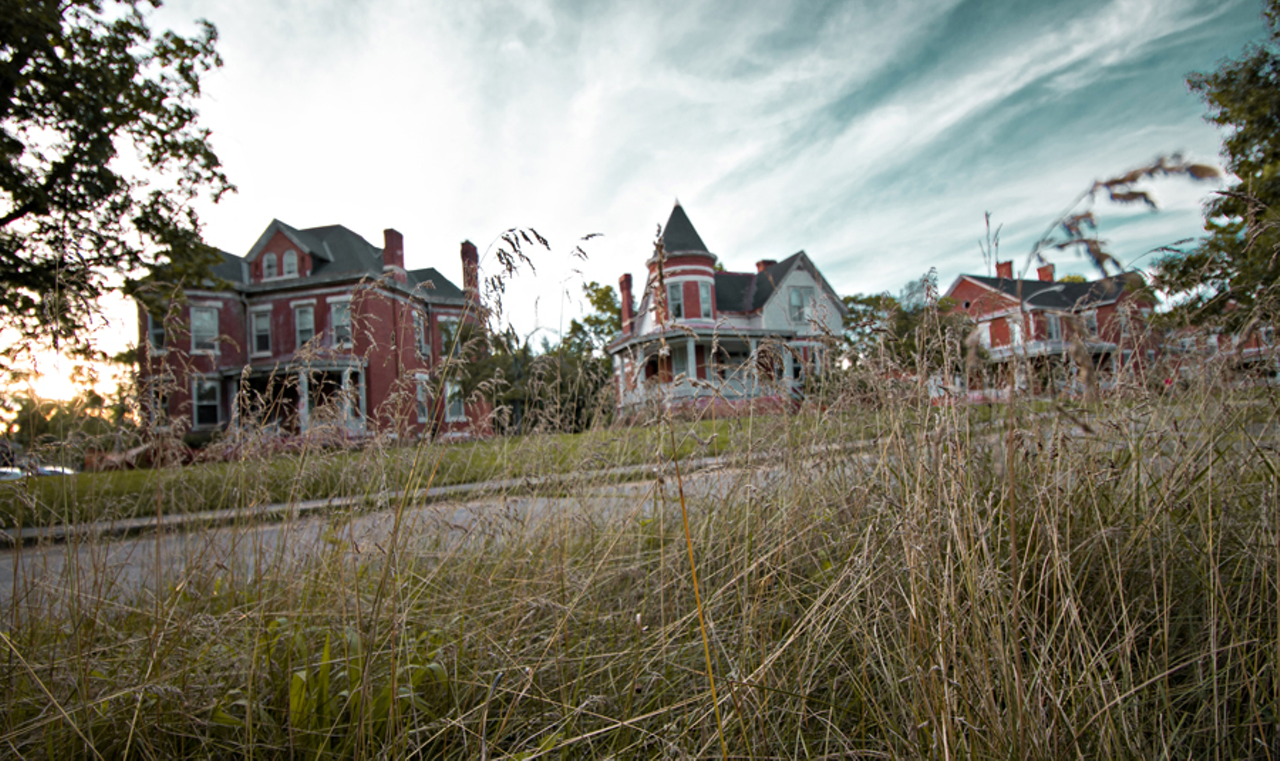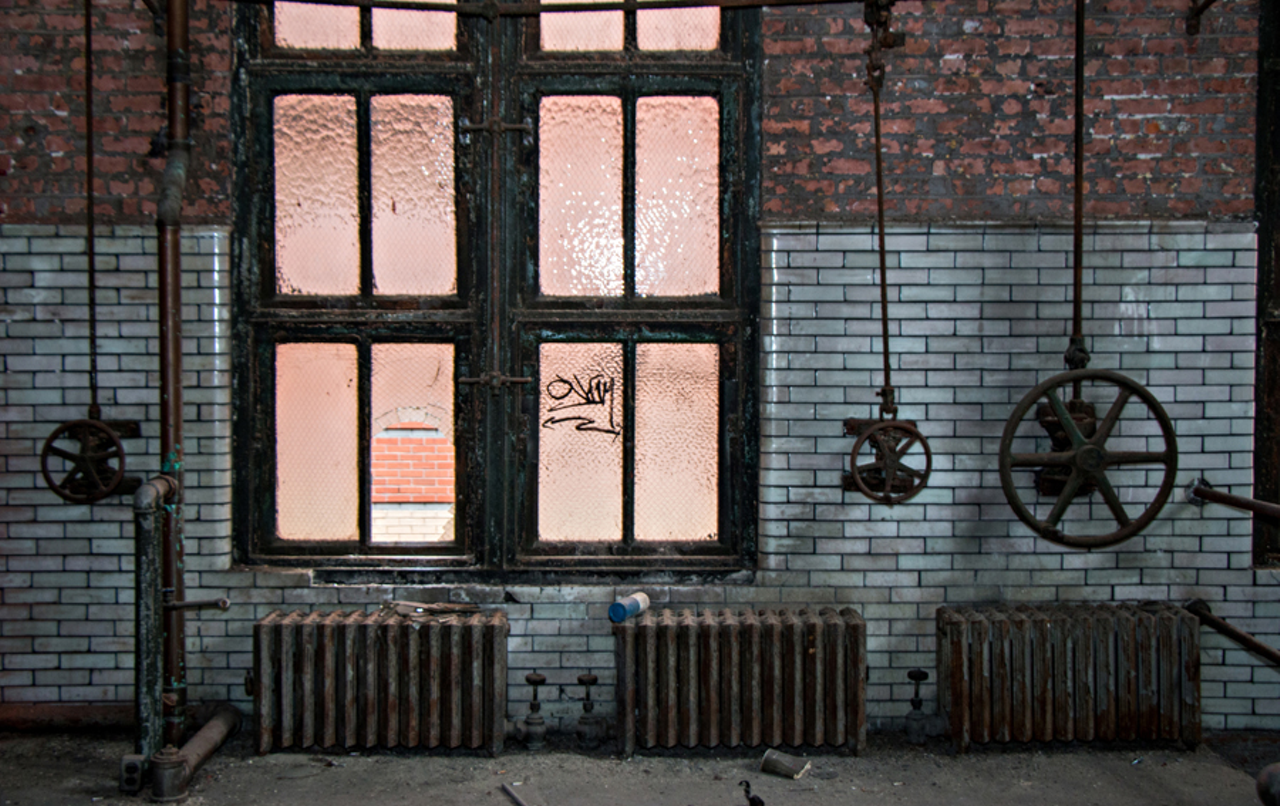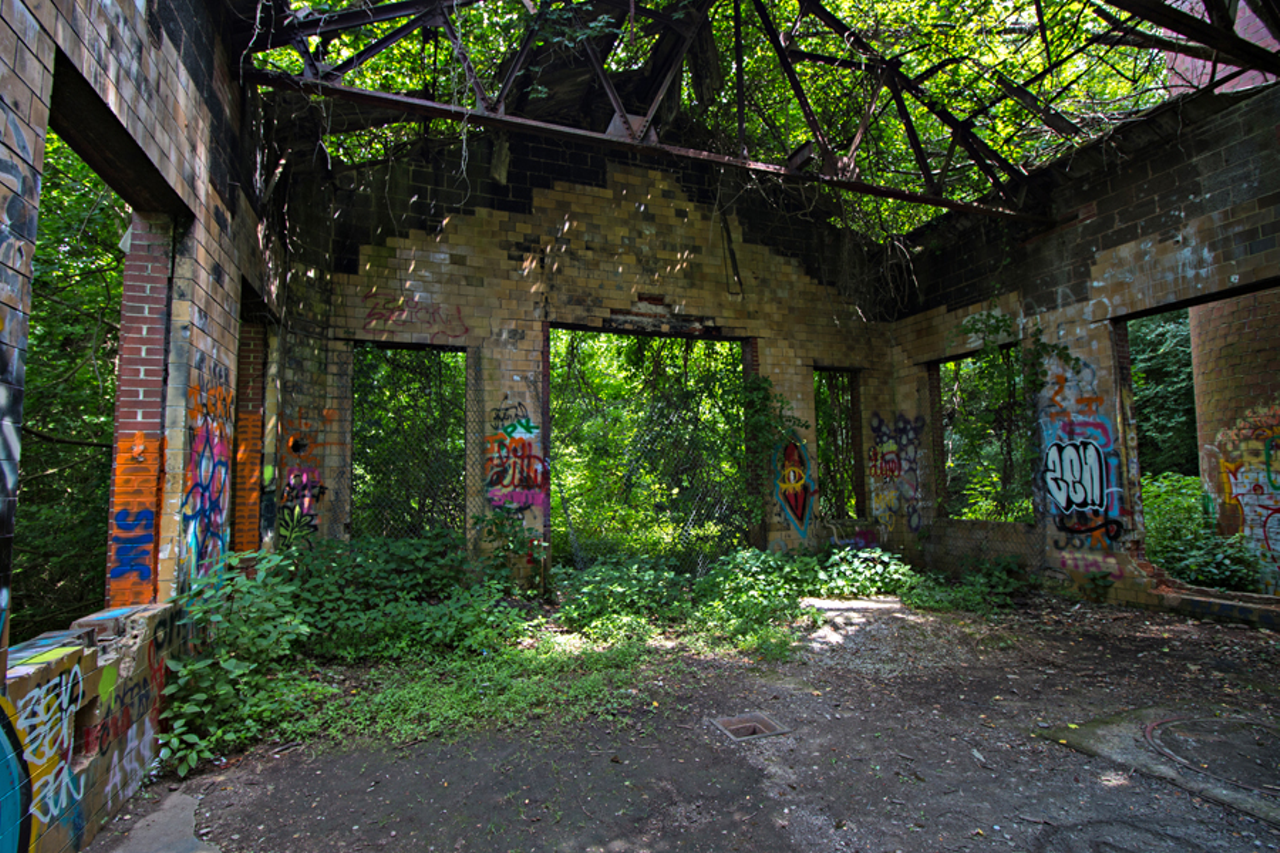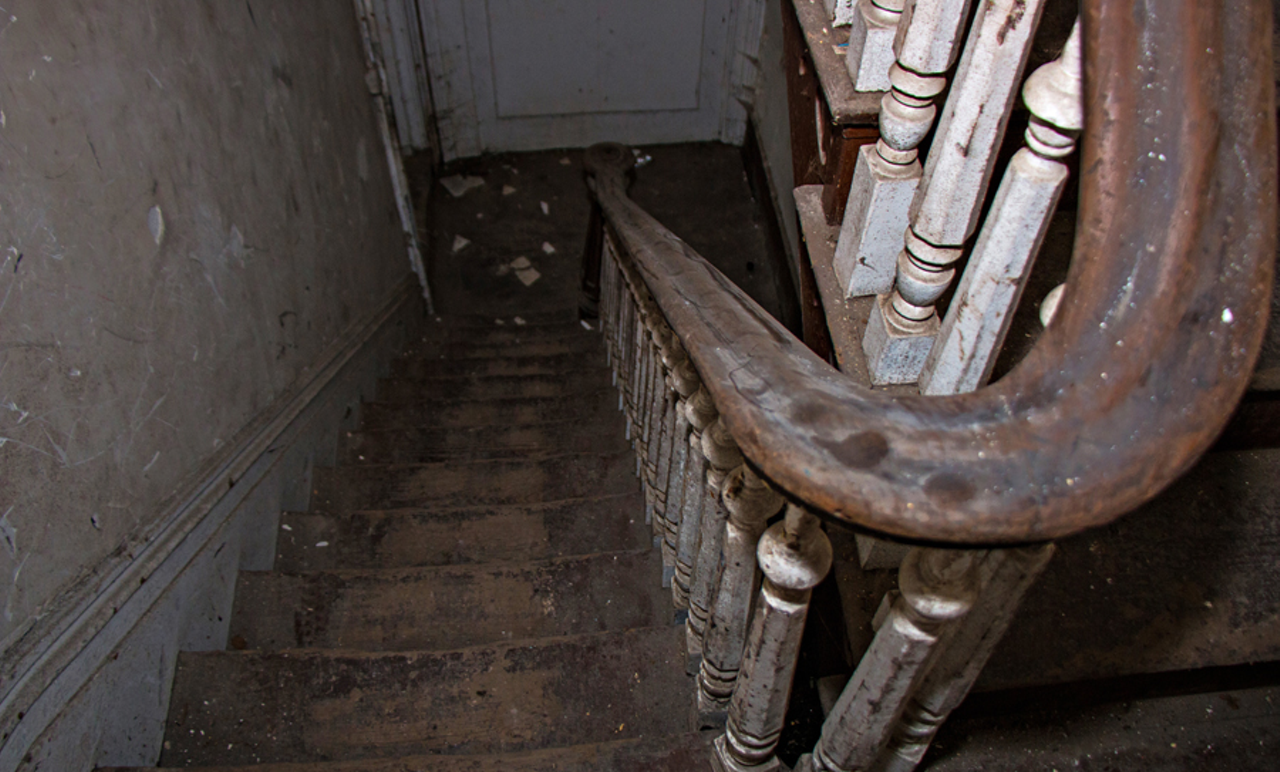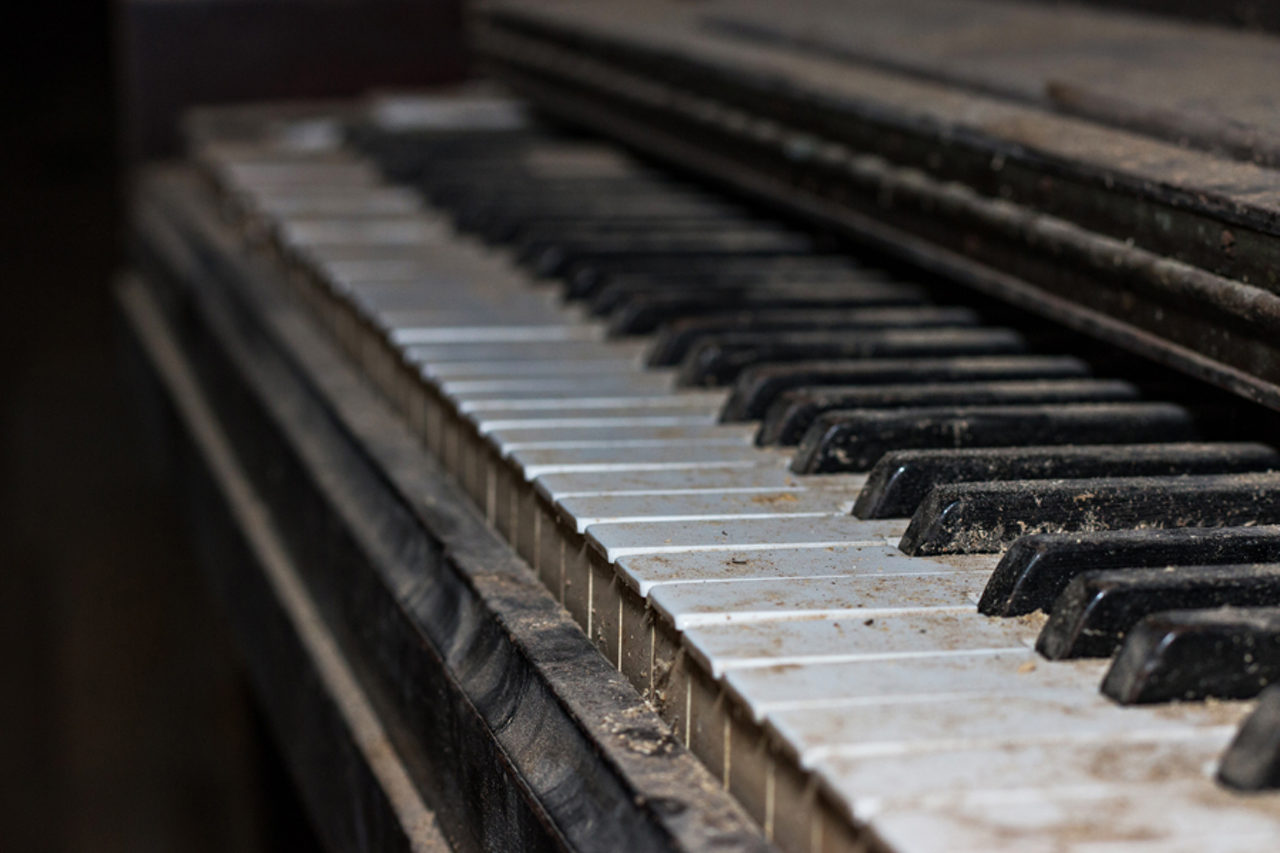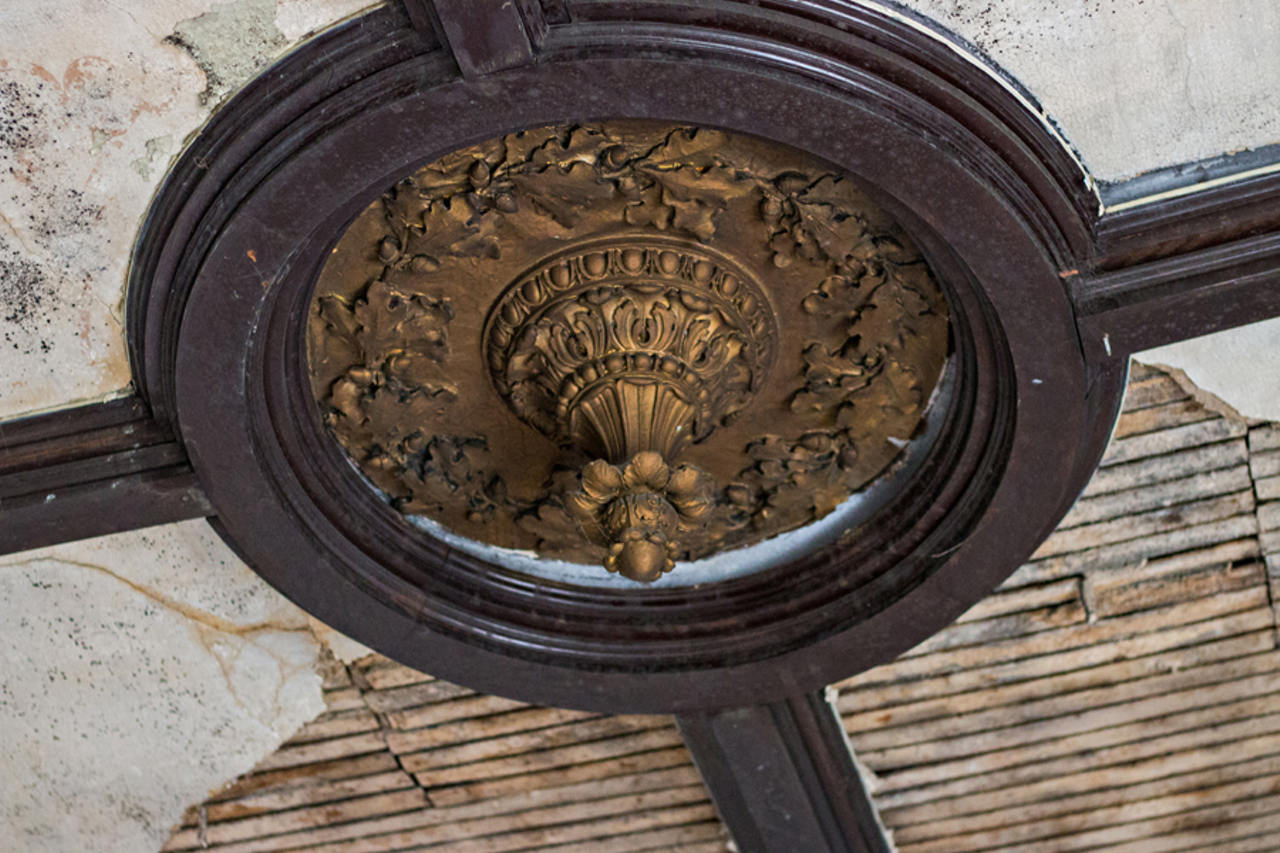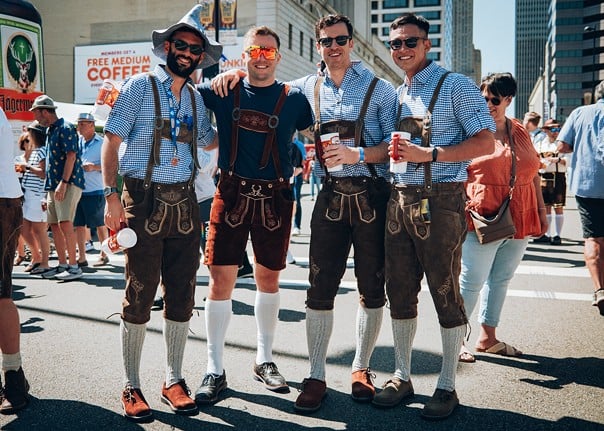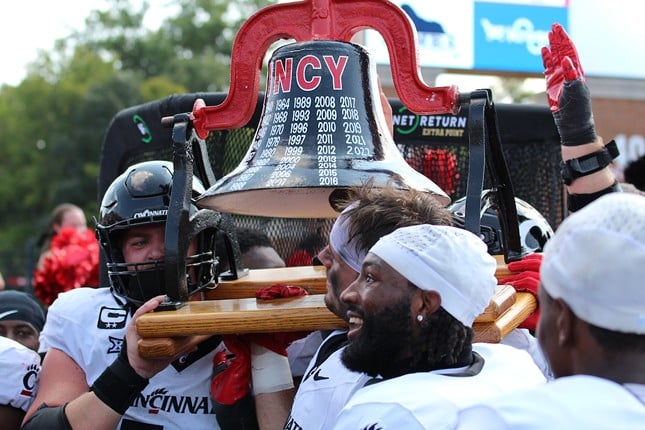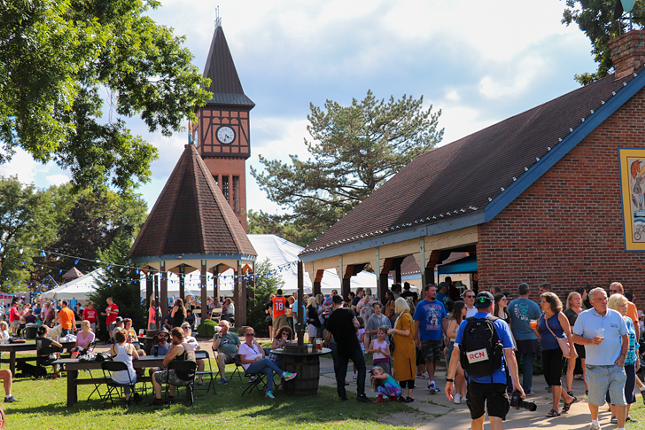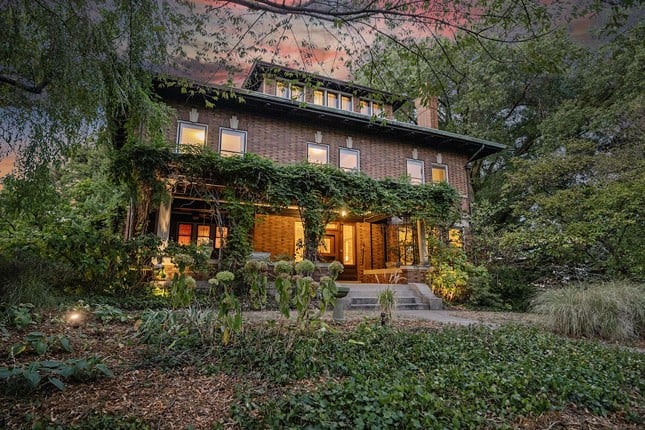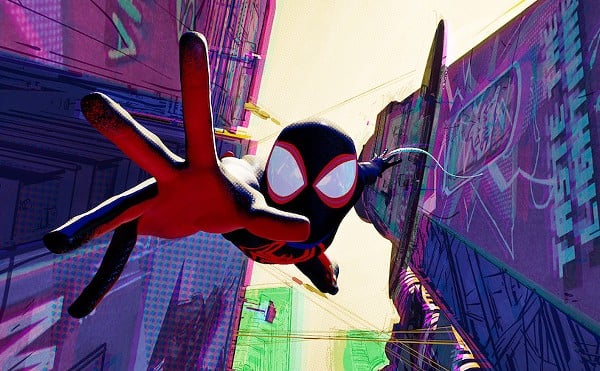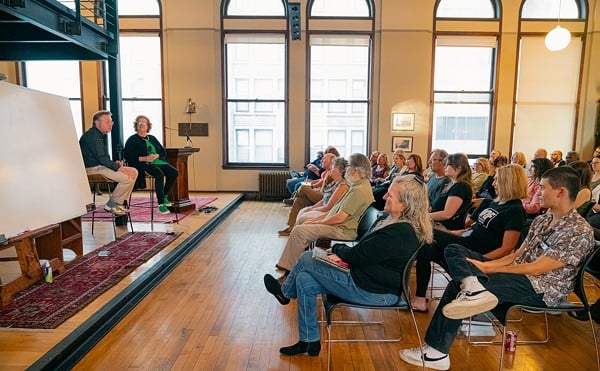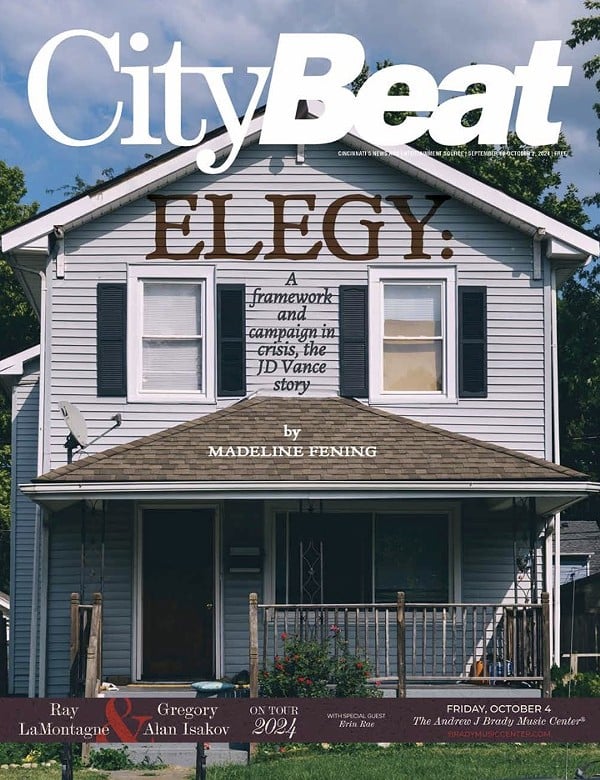It’s 9 a.m. on a drizzling, sizzling Friday as we pull up to the East Sixth Street curb outside Sotto downtown. The streets are eerily quiet for a workday, a fact that sets something of a Will-Smith-in-I-Am-Legend-type vibe.
Or maybe that’s just the spooky mood we’re looking for. After all, we’re on the hunt for that singular feeling you get when, despite the warm breeze and tranquil view from behind drugstore shades, a strange and sudden awareness that something is super off blows a chill through your bones.
We’re on a creepy summer field trip.
Our tour guides for this first leg, Sara Bedinghaus and Anthony Palazzolo, are sipping lattes and peering from beneath dripping umbrellas. As 3CDC employees, they hold the keys to much of the city’s urban stock — both its celebrated development projects and the lonelier, hidden spaces that are yet to be loved. It’s the latter we’re after today.
Following their lead, we duck down the aptly named Time Street, an unassuming alleyway populated by delivery carts, trash bins and restaurant workers having a morning smoke.
Unexpectedly, this weird shortcut dips between downtown buildings, takes a turn and empties abruptly upon another hulking structure — a building as substantial as its street-facing brethren, but squirreled away within the shadows, stealthily hidden from pedestrian view.
“As far as we know, it’s only ever been a power station, and most people just call it The Gano,” Bedinghaus tells us as we slip through a side door. “The real entrance is actually here. You have to watch your head.”
She’s pointing to a (small) person-sized hole near the ground. We eyeball it skeptically, but shimmy through nonetheless, avoiding the jagged concrete and broken bricks that grasp for our hair and claw at our windbreakers.
Once inside, the space opens up in spectacular fashion. True to description, it was clearly built for industry; it’s basically one cavernous room with expansive steel-frame windows and enormous I-beams — the type designed for passing heavy machinery from station to station.
The building shows up on a 1904 insurance survey, but there’s no record of when or by whom it was actually built. And, sadly for our purposes, no record of horrific human tragedies either. Bummer.
Today, it’s listed among 3CDC’s for-sale properties.
“We’ve had some interest,” Bedinghaus says. “One guy talked about turning it into a private residence. Another person wanted to make it an event space or a club. He said something about having a DJ swing around the ceiling on those beams.”
The notion of a swinging DJ is mildly intriguing, but on the creepy scale, this place barely registers — aside from the fact that nightly visitors to Igby’s patio revel without a clue that a quiet giant looms in the darkness just yards away.
Time to move on.
An evil sun has burned off any trace of morning haze by the time we slither back through the rabbit hole and make our way uptown.
We land in front of 1313 Vine St., the current home of Cintrifuse’s Union Hall entrepreneurial hub and co-working space.
The adjoining buildings at 1311-1315 are but one example of impressive 3CDC redevelopment, but as creepy goes, the scene is pretty meh. (Unless, of course, you were among the Goth/Punk club-goers who frequented this place when it was The Warehouse in the late 1990s, in which case you may well recall a few harrowing stories.)
That street-facing serenity begins to erode, however, as we descend past the friendly doorman and into the building’s historic sub-basement catacombs, where the temperature immediately plummets.
Long before tech entrepreneurs made it their home, Union Hall — the building’s original and current name — served a variety of purposes. As a beer garden, it hosted weddings, prize fights and other events, and it was often a gathering place for nationality groups from all over Europe.
The labyrinthine sub-basement yawns beneath ground from Vine Street to Republic, with dirt floors and barrel-vaulted stone arches that give it a distinctly subterranean feel as well as a humid, earthen aroma.
Our tour guides point out that prior to recent renovations, the only access to this sub-basement was via a steep ladder teetering dangerously close to an abandoned elevator shaft. No tragedy has befallen anyone here on 3CDC’s watch (that they know of), but like so many visitors to the catacombs, they’ve felt their neck hairs stand at attention down here for seemingly no particular reason and sensed panic gnawing gently at their spines when they’re last in a single-file line. It’s not the sort of place most people would want to spend time alone.
The sub-basement will no doubt soon be sold — hopefully to someone with plans that involve wine, prize fighting or both — and the space can continue softly beseeching regular folks to descend to its depths and drink away the paralyzing mortal fear that chuckles cruelly just beneath the surface.
We’re halfway across the Ohio River on the Anderson Ferry — a creepy ride in its own right by virtue of being a boat that carries cars across the river — as the mercury staggers past the 90-degree mark.
Approaching the Kentucky shore, we start to hear it. Rollercoaster wheels grinding against an unrelenting track. Ringleaders barking out the next sideshow. Banjos and brass bellowing songs of the day. Children shrieking with laughter… or are those screams?
In its heyday between 1895 and 1917, the Ludlow Lagoon Amusement Park drew enormous crowds — reportedly up to 70,000 visitors in one weekend — via trolleys leaving Fountain Square every two minutes.
Featuring rollercoasters, vaudeville acts and an 80-acre namesake lagoon that contained five separate islands, it was one of the biggest attractions in the nation.
“This place was absolutely crazy,” says Matt “Catfish” Williams. Catfish is a Ludlow city councilperson and owner of Folk School Coffee Parlor. Luckily for us, he’s also well versed in Ludlow’s creepy history.
“There were regular folks, sure,” he says. “But there were plenty of bad people who hung out there, too. There were gangsters and mistresses and murders and disappearances. There were gun fights. There were donkeys and horses jumping off the high-dive. It was like Vegas, or more like the Wild West.”
That is until a series of disastrous events brought operations to a screeching halt. Two of those disasters were unavoidable: a flood in 1913 and two years later, a tornado. But the motorcycle veering into the stands, knocking over a gas lamp and sparking an inferno that killed nine people and incited full-on panic? Well, folks maybe should have seen that one coming.
Even relying on historical photos, it’s hard to picture the park’s magnitude, since only two major structures remain. By 1930, even the lake had been filled in and the land covered over with crisscrossing streets and craftsman-style bungalows.
But a large clubhouse still remains, and we aim to explore it today.
Navigating thick underbrush full of ankle-biting fauna, we traipse — with permission, it should be noted — beyond the building’s rather ordinary façade, whose spires and gazebos have been removed and covered at some point in generic vinyl siding. But as we round the property’s southwest edge, the building begins to reveal its true face, the one we’ve seen in the postcards of the day, with signature gables and a sprawling “front” porch where a full Dixieland band reportedly played on hot summer nights.
Gazing at it from this angle, with the buried lagoon at our backs, we can almost see the throngs of families streaming down the broad front staircase, cotton candy on their lips as they clutch their tickets and jockey for line position.
Today, refuse clutters the property. A slumping brown Laz-E-Boy greets visitors in the portico. A four-foot snakeskin has been lazily draped across a once-proud wrought iron fence.
Transfixed as we are by this intersection of haunting beauty and vulgar modernity, we’re startled when a voice suddenly barks, “Hey, no more pictures! You have to leave.” It’s the property owner, who has apparently had a change of heart in the five minutes since we last spoke. “You have to get out. I have shit everywhere. Come back another time and I’ll show you whatever you want.”
Reluctantly, we retreat, stopping a block or so farther down on Lake Street to scout the amusement park’s only other remaining structure: a pool house. It just looks like a house.
The heat is veritably murderous now as we pack up and head for a nearby mom-and-pop saloon to rehash the day’s adventures over ice-cold rum and cokes. A local seated at a neighboring table eavesdrops unstealthily.
“Nah, the lagoon isn’t much to see,” she interjects loudly after a moment. “If you want creepy, you have to go to the incinerator just down the road. I heard they’re reopening it as part of a crime scene or cold case or whatever.”
We gulp our drinks and head for the door.
The Ludlow incinerator is, in a word, dank. It’s desperate and disconcertingly angry. Like someone dropped a pin in a Nirvana song.
Here’s the boring backstory the incinerator itself wants to sell you: It was built in 1940-something and used to burn trash (not bodies; don’t be crass) until 1960-something and then they closed it down and now it’s just part of a bike trail where teenagers sometimes get high or whatever and it’s fine.
But here’s what our gut instinct, our new friend back the bar and a 1967 Cincinnati Enquirer article tell us: The body of a Covington waitress, discovered one August evening near the incinerator, had been “…strangled with her own stocking knotted around her neck.” Um. Come again?
The jury is still out on a link between this very real, actual murder case and a spate of serial murders that took place between Cincinnati and Michigan back in the ’60s.
But even removing stocking murders from the equation: The incinerator is indeed creepy as hell.
The pervasive odor is legitimately unsettling — mostly because there is no way that decades-old, cremated trash is emitting that smell — but furthermore, one accesses this place via gravel path that meanders into the woods under a 200-foot railroad trestle straight out of Stand By Me.
There’s been talk between Ludlow and Covington groups of eventually removing or renovating the incinerator, but as it stands today, Earth is vying with skinheads and stoners for dominance in this place that is full of crumbling, graffitied brick, used condoms, empty beer cans and, honestly, god only knows what else.
So, sure. It’s fun to joke about Fort Thomas being creepy — with its perfectly manicured lawns, perfectly toned power-walkers and perfectly polished Range Rovers — but isn’t that really just a cover for jealousy and saltiness because their high school teams are better than many professional ones?
Real talk: The Fort has some legitimately upsetting history. In fact, scenic Tower Park might just be the creepiest stop on our list today. The picturesque greenspace is home to historic buildings, meandering trails, volleyball courts, children’s playgrounds and a converted armory that now houses basketball courts. But in 1977 it served as a temporary morgue for more than 100 unidentified victims of the infamous Beverly Hills Supper Club fire. Wait… what?
Seriously, that’s a horrible tragedy that totally happened, but we can’t focus on that right now because we have to talk about the fact that there’s no signage to prepare visitors hiking along the park’s northwestern edge for what they are about to encounter.
With a feeble last gasp, the dying sun sinks into the river as we crest the ridge and, completely out of nowhere, find ourselves smack-dab in the middle of Alexander Circle, an abandoned Victorian cul-de-sac, where nearly a dozen century-old mansions face one another around the commons, like a gorgeous clique of old friends mingling at a party that time forgot.
The residences at Alexander Circle, with their now withering gables and flagging verandas, were built in the 1880s and reserved for ranking officers and their families when Tower Park was an active military post.
One day soon, Fort Thomas’s city administrator Ron Dill tells us, a developer will restore these homes to their original beauty. In that process, they’ll undoubtedly unearth a treasure trove of oddities and artifacts that prompt more questions than answers. The transformed structures will sell for half a million or more, and the echoes of voices from a long and complicated past will recede another notch in volume as the circle begins anew.
Smirking stars begin dotting the sky as we make our way back to the car. Passing the largest house, the anchor property that would have been reserved for nothing less than a commandant, we glance up in time to see a faint light glimmering in a third story window. Almost on cue, it winks out, and then there is nothing but total darkness. ©
What’s Up with Weilert’s?
Boasting a 40-piece house band — the beginnings of the Cincinnati Symphony Orchestra — and an open-air biergarten that occupied an entire city block, Wielert’s Cafe and Pavilion was once Cincinnati’s premier social establishment.
And that’s saying something in a city that once prompted the famously axe-wielding prohibitionist Carrie Nation to exclaim, “My goodness, child, if I had undertaken to break all the windows of all the saloons on your Vine Street I would have dropped from exhaustion before I had gone a block.”
German transplant and Civil War veteran Heinrich Wielert might have been the owner, but his saloon at 1410 Vine St. was presided over by a man named George “Boss” Cox.
Born in Cincinnati in 1853, Cox did various stints as a butcher, delivery boy and shoe-shiner before opening a bookmaking operation he ran from his own rowdy saloon in the West End. By the 1880s, he had become the most powerful person in Cincinnati.
Cox built a business empire that included dozens of taverns, but he often held court in the beer garden at Wielert’s, meeting with associates like August “Garry” Herrmann, baseball’s first commissioner. It’s even rumored that the idea for the World Series was schemed up over beer and wienerschnitzel at Wielert’s.
The saloon closed in 1919 and became Gildehaus Funeral Home, followed by a cab company, church and, most recently, a daycare center. Today, Wielert’s stands vacant, one of Over-the-Rhine’s most visible blighted properties.
The Wielert building’s owners, 3CDC, have no immediate plans for its sale or renovation, but that could soon change, with Kroger’s forthcoming development expected to spark renewed interest in the 1400 block of Vine where the grocer’s sole downtown store is currently located. ©

